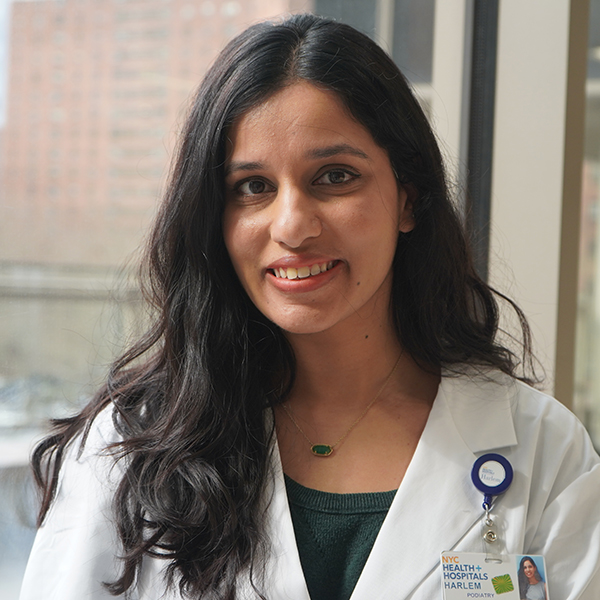In Step with Foot Health
Our Podiatry experts offer tips for health, happy feet
From preventing Athlete’s Foot to shoe shopping, Dr. Alfred Garofalo, Chief of Podiatric Surgical and Medical Service at NYC Health + Hospitals/Bellevue and Dr. Riddhi Shah, Podiatric Physician, NYC Health + Hospitals/Gotham Health offer advice on how to keep our feet happy and healthy.

Chief of Podiatric Surgical and Medical Service
NYC Health + Hospitals/Bellevue

Podiatric Physician
NYC Health & Hospitals/Gotham Health
Q: Why is foot health important to our overall well-being? How does one’s overall health (like diabetes or circulation issues) impact their foot health, and vice versa?
Dr. Garofalo: Feet truly are the unsung heroes of our bodies. They carry us through our life, quite literally, and the average individual unknowingly places pedal care lower on their list of concerns which can cause ripple effects on overall well-being—whether its discomfort affecting your mood or more serious complications due to underlying conditions like diabetes or peripheral vascular issues (poor circulation).
Dr. Shah: Our feet are the main foundation of our body, as they are our primary mode of transportation. Concurrently, our body is connected as a whole, so other medical problems such as diabetes, heart disease, circulation issues can lead to foot problems like neuropathy, swelling, foot wounds, and even fractures. Other medical issues can impair our body to fight foot problems causing more strain and stress.
Q: Many people neglect their feet. What are the early warning signs that someone should seek professional podiatric care?
Dr. Garofalo: People should be encouraged to seek Podiatric Medical advice as soon as they notice any unusual changes or persistent discomfort in their feet or lower legs. Regular screenings, maintaining good blood sugar control, and ensuring proper circulation through exercises help manage these risks. Some of the warning signs are numbness, burning sensations, aching pain, and unexplained fatigue. All of these are critical signs that shouldn’t be overlooked. For individuals with diabetes or vascular conditions, these symptoms sometimes signal early complications like diabetic neuropathy or peripheral arterial disease (PAD). Early recognition and intervention are crucial to preventing further progression.
Dr. Shah: Examining our feet daily is essential for maintaining healthy feet. Take a quick look at the top and soles of your feet, as well as in-between your toes, and toenails. If there are changes such as a growth, discoloration, pain, or swelling, it can be due to circulation, infection, or even bone or tendon injury. A change in skin appearance (i.e. soft tissue mass, freckle, new or increased growth of a mole) needs to be evaluated for possible skin or soft tissue cancer. For people that may have challenges looking at the bottom of their feet my simple solution is this – place a small facial mirror next to your shoes and each morning, take a quick glance down to assure all is well.
Q: What are some common mistakes people make when choosing shoes? What advice would you give to hospital/facility staff who are on their feet for long hours to maintain good foot health?
Dr. Garofalo: Many problems stem from prolonged use of ill-fitting or unsupportive shoes, so stressing practical comfort is key. The biggest challenge I see is people assigning too much value to a particular brand name. A brand name shouldn’t be the determining factor when it comes to choosing footwear. Educating patients on what truly matters—function, fitness, and structure—is such a vital part. A few key features are:
- Flexibility – a shoe should bend only at the toe box and not in the middle.
- Heel Height – a high heel, although appealing, often increases the risk of instability and arch strain.
- Width and Fit – to assure comfortability for long term use.
I also recommend to my diabetic patients to purchase seamless socks. These can be commonly found online such as “Diabetic Socks” or even in sporting goods stores as many runner socks are made without seams to reduce irritation during running. These tips could also be useful for hospital staff who are on their feet for many hours.
Dr. Shah: Poorly fitting or tight shoes can cause foot pain leading to callus, blisters, and ulcerations. Nowadays, name brand shoes especially certain styles with heels or pointed toes can look fashionable, but they can also cause long-term foot damage. Instead I encourage patients and hospital staff alike to wear supportive footwear with orthotics, take regular breaks at work to rest and elevate feet, use anti-fatigue mats when standing for long periods of time, and wear compression socks to prevent leg fatigue and varicose veins.
Q: Are there any specific foot health issues that tend to become more prevalent during the spring and summer months, and how can people prepare for them?
Dr. Garofalo: Higher prevalence during these seasons is Athlete’s Foot. This is one of the most common (fungal) infections mostly caused by warm, moist environments—think socks or shoes. Proper hygiene and prevention are key to managing it. Also high during those months is the risk of stepping on foreign bodies caused by walking barefoot or in open shoes like sandals and clogs without socks. We especially see a higher rate of foreign bodies from walking along the beach or in the ocean and inadvertently stepping on objects that sometimes are so sharp that the individual barely detects that trauma.
Dr. Shah: Post-pandemic, there has been increased participation in walking, running, and sports resulting in overuse injuries (like tendonitis) from increased strain. In the spring we typically see more Athlete’s Foot, blisters, and plantar fasciitis.
- Athlete’s Foot: A fungal infection that results from a warm moist environment causing feet itching, scaling, and burning. To prevent this, change socks daily, keep feet dry, and wear slippers or sandals in communal areas.
- Blisters: It is common to see foot blisters in activities like hiking, running, and walking long distance. Wear shoes with proper cushion support and socks to help prevent this.
- Plantar fasciitis: A condition where the plantar fascia band ranges from heel to toes is inflamed causing heel pain worst in the mornings or increased pain while standing or walking. Wearing flat sandals (flip-flops) or walking barefoot will worsen this syndrome. Remember to stretch calves regularly, and wear shoe gear with arch support and heel cushion to help prevent this.
Q: For those who may not prioritize foot health, what are some simple steps they can take to improve their foot care routine?
Dr. Garofalo: Look at your feet each day, focus on regular check-ups, proper footwear, and daily care like moisturizing. Inspecting for any changes can make a significant difference. Even something as simple as gentle foot exercises and massages can improve circulation and strengthen musculature.
Dr. Shah:
- Avoid wearing tight shoes, and high heels, which can lead to pain, discomfort, and long-term joint or muscle damage. Instead look for shoe gear that is wide, has adequate arch support, and room for toes to move.
- Clean feet and change socks daily to prevent fungal or bacterial infections. Apply moisturizer thoroughly on top, soles, and heel.
- Trim long toenails straight across, and avoid cutting the nail with a rounded/angled cut or trimming nails too short. This can lead to ingrown nail pain and infections.
- Wear slippers and house sandals. Avoid being barefoot. Wear cushioned sandals (i.e.: memory foam) or socks to avoid foot pain and accidental injuries from stepping on foreign bodies.
Q: And now to solve, one of the most serious medical mysteries: Why do some people have ticklish feet and others don’t?
Dr. Garofalo: Good Question and here is my medical response. Our soles of our feet have been noted to be the most ticklish parts of the body and this is because of a high concentration of nerve endings. Perhaps it can be part of our evolutionary and physical makeup as these sensory receptors are sensitive to touch and pressure which help us detect changes in land and dangers when walking barefoot.
Dr. Shah: The sensitive area on feet acts as a defense mechanism. Having ticklish feet is a good sign as the area is very sensitive due to high concentration of nerves (around 8000 thousand nerve endings). These pain and touch receptors protect the feet from injury.
Q: As a podiatrist, what is your funniest foot joke? Or most interesting foot health fun fact?
Dr. Garofalo: Patients often ask if they’re going to have the same foot problems as their parents or other relatives. The answer to that question varies. Remember, we can’t pick our feet. Genetics play a major role in our development, and certain foot problems can be linked to similar bone and muscular structure as a relative. But even so, there are still a number of things we can do to help keep our feet healthy throughout our lifetime of use.
Dr. Shah:
Why did the foot go to medical school? Because it wanted to heel people!
What’s a foot’s favorite type of candy? Tootsie Rolls, obviously!
